
Avalanche rescue
Encyclopedia
What is an avalanche
An avalanche is a mass of snow and ice that breaks, falls, or slides off a mountain, hill, or any slope, including a rooftop.Avalanche Rescue
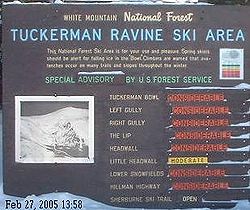
Backcountry skiing
Backcountry skiing is skiing in a sparsely inhabited rural region over ungroomed and unmarked slopes or pistes, including skiing in unmarked or unpatrolled areas either within the ski resort's boundaries or in the backcountry, frequently amongst trees , usually in pursuit of fresh fallen powder...
(off-piste) is never 100% safe. Good avalanche safety is a continuous process, including route selection and examination of the snowpack, weather conditions, and human factors. Several well-known good habits can also minimize the risk. If local authorities issue avalanche risk reports, they should be considered and all warnings heeded. Never follow in the tracks of others without your own evaluations; snow conditions are almost certain to have changed since they were made. Observe the terrain and note obvious avalanche paths where vegetation is missing or damaged, where there are few surface anchors, and below cornices or ice formations. Avoid travelling below others who might trigger an avalanche.
Prevention
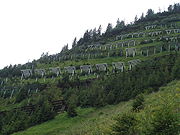
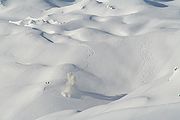
There are several ways to prevent avalanches and lessen their power and destruction. They are employed in areas where avalanches pose a significant threat to people, such as ski resort
Ski resort
A ski resort is a resort developed for skiing and other winter sports. In Europe a ski resort is a town or village in a ski area - a mountainous area, where there are ski trails and supporting services such as hotels and other accommodation, restaurants, equipment rental and a ski lift system...
s and mountain towns, roads and railways. Explosives are used extensively to prevent avalanches, especially at ski resorts where other methods are often impractical. Explosive charges are used to trigger small avalanches before enough snow can build up to cause a large avalanche. Snow fence
Snow fence
A snow fence is a structure, similar to a sand fence, that forces drifting snow to accumulate in a desired place. They are primarily employed to minimize the amount of snowdrift on roadways and railways. Farmers and ranchers may use temporary snow fences to create large drifts in basins for a...
s and light walls can be used to direct the placement of snow. Snow builds up around the fence, especially the side that faces the prevailing wind
Wind
Wind is the flow of gases on a large scale. On Earth, wind consists of the bulk movement of air. In outer space, solar wind is the movement of gases or charged particles from the sun through space, while planetary wind is the outgassing of light chemical elements from a planet's atmosphere into space...
s. Downwind of the fence, snow buildup is lessened. This is caused by the loss of snow at the fence that would have been deposited and the pickup of the snow that is already there by the wind, which was depleted of snow at the fence. When there is a sufficient density of tree
Tree
A tree is a perennial woody plant. It is most often defined as a woody plant that has many secondary branches supported clear of the ground on a single main stem or trunk with clear apical dominance. A minimum height specification at maturity is cited by some authors, varying from 3 m to...
s, they can greatly reduce the strength of avalanches. They hold snow in place and when there is an avalanche, the impact of the snow against the trees slows it down. Trees can either be planted or they can be conserved, such as in the building of a ski resort, to reduce the strength of avalanches.
Artificial barriers can be very effective in reducing avalanche damage. There are several types. One kind of barrier (snow net) uses a net strung between poles that are anchored by guy wires in addition to their foundations. These barriers are similar to those used for rockslide
Rockslide
A rockslide is a type of landslide caused by rock failure in which part of the plane of failure passes through intact rock and where material collapses en masse and not in individual blocks.The mode of failure is different from that of a rock-fall....
s. Another type of barrier is a rigid fence like structure (snow fence
Snow fence
A snow fence is a structure, similar to a sand fence, that forces drifting snow to accumulate in a desired place. They are primarily employed to minimize the amount of snowdrift on roadways and railways. Farmers and ranchers may use temporary snow fences to create large drifts in basins for a...
) and may be constructed of steel
Steel
Steel is an alloy that consists mostly of iron and has a carbon content between 0.2% and 2.1% by weight, depending on the grade. Carbon is the most common alloying material for iron, but various other alloying elements are used, such as manganese, chromium, vanadium, and tungsten...
, wood
Wood
Wood is a hard, fibrous tissue found in many trees. It has been used for hundreds of thousands of years for both fuel and as a construction material. It is an organic material, a natural composite of cellulose fibers embedded in a matrix of lignin which resists compression...
or pre-stressed concrete
Concrete
Concrete is a composite construction material, composed of cement and other cementitious materials such as fly ash and slag cement, aggregate , water and chemical admixtures.The word concrete comes from the Latin word...
. They usually have gaps between the beams and are built perpendicular to the slope, with reinforcing beams on the downhill side. Rigid barriers are often considered unsightly, especially when many rows must be built. They are also expensive and vulnerable to damage from falling rocks in the warmer months. Finally, there are barriers that stop or deflect avalanches with their weight and strength. These barriers are made of concrete, rocks or earth. They are usually placed right above the structure, road or railway that they are trying to protect, although they can also be used to channel avalanches into other barriers. Occasionally, earth mounds are placed in the avalanche's path to slow it down.
Safety in avalanche terrain
- Terrain management - Terrain management involves reducing the exposure of an individual to the risks of travelling in avalanche terrain by carefully selecting what areas of slopes to travel on. Features to be cognizant of include not undercutting slopes (removing the physical support of the snow pack), not travelling over convex rolls (areas where the snow pack is under tension), staying away from weaknesses like exposed rock, and avoiding areas of slopes that expose one to terrain traps (gulleys that can be filled in, cliffs over which one can be swept, or heavy timber into which one can be carried).
- Group management - Group management is the practice of reducing the risk of having a member of a group, or a whole group involved in an avalanche. Minimize the number of people on the slope, and maintain separation. Ideally one person should pass over the slope into an area protected from the avalanche hazard before the next one leaves protective cover. Route selection should also consider what dangers lie above and below the route, and the consequences of an unexpected avalanche (i.e., unlikely to occur, but deadly if it does). Stop or camp only in safe locations. Wear warm gear to delay hypothermia if buried. Plan escape routes. In determining the size of the group balance the hazard of not having enough people to effectively carry out a rescue with the risk of having too many members of the group to safely manage the risks. It is generally recommended not to travel alone, because there will be no-one to witness your burial and start the rescue. Additionally, avalanche risk increases with use; that is, the more a slope is disturbed by skiersSkiingSkiing is a recreational activity using skis as equipment for traveling over snow. Skis are used in conjunction with boots that connect to the ski with use of a binding....
, the more likely it is that an avalanche will occur. Most important of all practise good communication within a group including clearly communicating the decisions about safe locations, escape routes, and slope choices, and having a clear understanding of every members skills in snow travel, avalanche rescue, and route finding.
- Risk Factor Awareness - Risk factor awareness in avalanche safety requires gathering and accounting for a wide range of information such as the meteorological history of the area, the current weather and snow conditions, and equally important the social and physical indicators of the group.
- Leadership - Leadership in avalanche terrain requires well defined decision making protocols that use the observed risk factors. These decision making frameworks are taught in a variety of courses provided by national avalanche resource centres in Europe and North America. Fundamental to leadership in avalanche terrain is honestly assessing and estimating the information that was ignored or overlooked. Recent research has shown that there are strong psychological and group dynamic determinants that lead to avalanche involvement.
Human survival and avalanche rescue
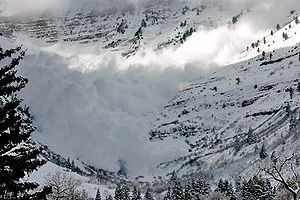
Research carried out in Switzerland
Switzerland
Switzerland name of one of the Swiss cantons. ; ; ; or ), in its full name the Swiss Confederation , is a federal republic consisting of 26 cantons, with Bern as the seat of the federal authorities. The country is situated in Western Europe,Or Central Europe depending on the definition....
based on 638 buried persons in open areas indicates how the chances of survival depends on time of burial:
- drops very rapidly from 91 percent within 18 minutes ("survival phase") to only 34 percent after 35 minutes ("asphyxia phase")
- levels out between 35 and 90 minutes because of survival of people with patent airways ("latent phase")
- drops again to 7 percent as those buried eventually succumb to lethal hypothermiaHypothermiaHypothermia is a condition in which core temperature drops below the required temperature for normal metabolism and body functions which is defined as . Body temperature is usually maintained near a constant level of through biologic homeostasis or thermoregulation...
complicated by progressive hypoxiaHypoxia (medical)Hypoxia, or hypoxiation, is a pathological condition in which the body as a whole or a region of the body is deprived of adequate oxygen supply. Variations in arterial oxygen concentrations can be part of the normal physiology, for example, during strenuous physical exercise...
and hypercapniaHypercapniaHypercapnia or hypercapnea , also known as hypercarbia, is a condition where there is too much carbon dioxide in the blood...
("hypothermia phase").
Consequently it is vital that everyone surviving an avalanche is used in an immediate search and rescue operation, rather than waiting for help to arrive. Additional help can be called once it can be determined if anyone is seriously injured or still remains unaccountable after the immediate search (i.e., after at least 30 minutes of searching). Even in a well equipped country such as France
France
The French Republic , The French Republic , The French Republic , (commonly known as France , is a unitary semi-presidential republic in Western Europe with several overseas territories and islands located on other continents and in the Indian, Pacific, and Atlantic oceans. Metropolitan France...
, it typically takes 45 minutes for a helicopter rescue team to arrive, by which time most of the victims are likely to have died.
In some cases avalanche victims are not located until spring thaw melts the snow, or even years later when objects emerge from a glacier.
Search and rescue equipment

All travelers venturing onto snow-covered slopes should remember that using the right equipment does not justify exposing yourself to unnecessary risks with the hope that the equipment might save your life when it is needed. The gear makes rescue faster; there is no guarantees for your survival.
Avalanche cords
An avalanche cord is the oldest form of equipment — mainly used before beacons became available. The principle is simple. An approximately 10 meter long red cord (similar to parachute cord) is attached to the person in question's belt. While skiing, snowboarding, or walking the cord is dragged along behind the person. If the person gets buried in an avalanche, the light cord stays on top of the snow. Due to the color the cord is easily visible for rescue personnel. Typically the cord has metal markings every one meter that indicate the direction and length to the victim. Unfortunately, avalanche cords have been demonstrated to be ineffective and should not be used.Beacons
Beacons — known as "beepers", peeps (pieps), ARVAs (Appareil de Recherche de Victimes en Avalanche, in French), LVS (Lawinen-Verschütteten-Suchgerät, Swiss German), avalanche transceiverTransceiver
A transceiver is a device comprising both a transmitter and a receiver which are combined and share common circuitry or a single housing. When no circuitry is common between transmit and receive functions, the device is a transmitter-receiver. The term originated in the early 1920s...
s, or various other trade names, are important for every member of the party. They emit a "beep" via 457 kHz radio signal in normal use, but may be switched to receive mode to locate a buried victim up to 80 meters away. Analog receivers provide audible beeps that rescuers interpret to estimate distance to a victim. To use the receiver effectively requires regular practice. Some older models of beepers operated on a different frequency (2.275 kHz ) and a group leader should ensure these are no longer in use.
Since about 2000 nearly all avalanche rescue transceivers use digital displays to give visual indications of direction and distance to victims. Most users find these beacons easier to use, but to be effective still requires considerable practice by the user. Beacons are the primary rescue tool for companion rescue and are considered active devices because the user must learn to use and care for their device.
Probes

Probing can be a very time-consuming process if a thorough search is undertaken for a victim without a beacon. In the U.S., 86% of the 140 victims found (since 1950) by probing were already dead. http://outsideonline.com/outside/magazine/200002/200002ava_whitedeath7.html Survival/rescue more than 2 m deep is rare (about 4%). Probes should be used immediately after a visual search for surface clues, in coordination with the beacon search.
Shovels
When an avalanche stops, the deceleration normally compresses the snow to a hard mass. Shovels are essential for digging through the snow to the victim, as the deposit is often too dense to dig with hands or skis. A large scoop and sturdy handle are important. Shovels are also useful for digging snow pits as part of evaluating the snow pack for hidden hazards, such as weak layers supporting large loads.RECCO Rescue System
The Recco system is used by organized rescue services around the world. The Recco system is a two-part system where the rescue team uses a small hand-held detector. The detector receives a directional signal that is reflected back from a small, passive, transponder called a reflector that is included into outerwear, boots, helmets, and body protection. Recco reflectors are not a substitute for avalanche beacons. The Recco signal does not interfere with beacons. In fact, the current Recco detector also has an avalanche beacon receiver (457kHz) so one rescuer can search for a Recco signal and a beacon signal at the same time.Avalung
Recently, a device called an Avalung has been introduced for use in avalanche terrain. The device consists of a mouth piece, a flap valve, an exhaust pipe, and an air collector, several models of Avalung either mount on one's chest or integrate in a proprietary backpack.During an avalanche burial, victims not killed by trauma usually suffer from suffocation as the snow around them melts from the heat of the victims breath and then refreezes, disallowing oxygen flow to the victim & allowing toxic levels of CO2 to accumulate. The Avalung ameliorates this situation by drawing breath over a large surface area in front and pushing the warm exhaled carbon dioxide behind. This buys additional time for rescuers to dig the victim out.
Avalanche airbags
Avalanche airbags help a person avoid burial by making the user an even larger object relative to the moving snow, which forces the person toward the surface. Avalanche airbags work on the principle of inverse segregation. Avalanches, like mixed nuts and breakfast cereal are considered granular materials and behave fluid-like (but are not liquids) where smaller particles settle to the bottom of the flow and larger particles rise to the top. Provided the airbag is properly deployed, the chances of a complete burial are significantly reduced.More back-country adventurers are also carrying Satellite Electronic Notification Devices (SEND) to quickly alert rescuers to a problem. These devices include the SPOT Messenger, Emergency Position-Indicating Radio Beacon
Emergency Position-Indicating Radio Beacon
Distress radio beacons, also known as emergency beacons, ELT or EPIRB, are tracking transmitters which aid in the detection and location of boats, aircraft, and people in distress. Strictly, they are radiobeacons that interface with worldwide offered service of Cospas-Sarsat, the international...
(EPIRB) or Personal Locating Beacons (PLBs) containing the Global Positioning System
Global Positioning System
The Global Positioning System is a space-based global navigation satellite system that provides location and time information in all weather, anywhere on or near the Earth, where there is an unobstructed line of sight to four or more GPS satellites...
(GPS). This device can quickly notify search and rescue of an emergency and the general location (within 100 yards), but only if the person with the EPIRB has survived the avalanche and can activate the device. Survivors should also try to use a mobile phone
Mobile phone
A mobile phone is a device which can make and receive telephone calls over a radio link whilst moving around a wide geographic area. It does so by connecting to a cellular network provided by a mobile network operator...
to notify emergency personnel. Unlike the other devices mentioned above, the mobile phone (or satellite phone) provides two-way communications with rescuers.
On-site rescuers (usually companions) are in the best position to save a buried victim. However, organized rescue teams can sometimes respond very quickly to assist in the search for a buried victim. The sooner organized rescue can be notified the sooner they can respond, and this difference can mean the difference in living or dying for a critically injured patient. The International Commission for Alpine Rescue recommends, “early notification is essential, e.g., by mobile phone, satellite phone, or radio, wherever possible”
Other rescue devices are proposed, developed and used, such as avalanche balls, vests and airbags, based on statistics indicating that decreasing the depth of burial increases the chances of survival.
Although inefficient, some rescue equipment can be improvised by unprepared parties: ski poles can become short probes, skis or snowboards can be used as shovels. A first aid kit and equipment is useful for assisting survivors who may have cuts, broken bones, or other injuries, in addition to hypothermia
Hypothermia
Hypothermia is a condition in which core temperature drops below the required temperature for normal metabolism and body functions which is defined as . Body temperature is usually maintained near a constant level of through biologic homeostasis or thermoregulation...
.
Self-Rescue
Victims caught in an avalanche are advised to try to escape to side of the avalanche. If not possible, grab onto a tree, brush or rock (each second one hangs on lets snow pass by that cannot bury one). If knocked off one's feet, then jettison their equipment (if possible) and FIGHT for your life. Rolling like a log may help one escape to the side. Conventional wisdom says to make swimming motions to stay on the surface. Anecdotal stories tell successes; however, analysis of avalanche motion and physics dispute swimming. Avalanches stop quickly and if under the snow it is critical to get a hand in front of the face to create an airspace before the snow stops. If one is near the surface they may try to thrust an arm, leg or object above the surface. If it is possible, try to break free once the snow stops. If unable to move do not struggle except to enlarge the air space.Companion Rescue
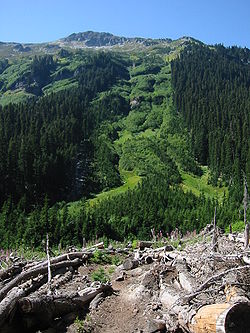
Witnesses to an avalanche that engulfs people are frequently limited to those in the party involved in the avalanche. Those not caught should try to note the locations where the avalanched person or persons were last seen. In fact, anyone planning to enter an avalanche area should discuss this step as part of their preparation. Once the avalanche has stopped and the danger of secondary slides has passed, witnesses should mark these points with objects for reference. Then, survivors should take a headcount to determine who may be lost. If the area is safe to enter, the searchers should visually scan along a downslope trajectory from the marked points last seen. Victims who are partially or shallowly buried can often be located quickly by visually scanning the avalanche debris and pulling out clothing or equipment that may be attached to someone buried.
Because survival rates plummet as time passes, do not send a searcher for help until you feel you can do no more. However, do use your mobile phone or radio to call for help as soon as you suspect a burial. Generally, the telephone connection will be be better from the top of a slope than from the bottom. Go to and mark the Last Seen Area, switch transceivers to receive mode, and check them. Select likely burial areas and search them, listening for beeps (or voices), expanding to other areas of the avalanche, always looking and listening for other clues (movement, equipment, body parts). Probe randomly in probable burial areas. Mark any points where signal was received or equipment found. Continue scanning and probing near marked clues and other likely burial areas. After 30 to 60 minutes, consider sending a searcher to get more help, because at this point, the remaining victims have probably not survived.
Line probes are arranged in most likely burial areas and marked as searched. Continue searching and probing the area until it is no longer feasible or reasonable to continue. Avoid contaminating the scent of the avalanche area with urine, food, spit, blood, etc., in case search dogs arrive.
Buried victims are most likely to be found--
• Below the marked point last seen
• Along the line of flow of the avalanche
• Around trees and rocks or other obstacles
• Near the bottom runout of the debris
• Along edges of the avalanche track
• In low spots where the snow may collect (gullies, crevasses, creeks, ditches along roads, etc.)
Although less likely, check other areas if initial searches are not fruitful.
Once buried victims are found and their heads and chests are freed, perform first aid (airway, breathing, circulation/pulse, arterial bleeding, spinal injuries, fractures, shock, hypothermia, internal injuries, etc.), according to local law and custom.
Organized Rescue
Professional and volunteer rescue teams respond when a victim needs more help than their companions can provide. Traditionally, organized rescue responded after companion rescue efforts failed. However, today, thanks to mobile telephones, helicopters and snow-machines, the distinction between organized and companion rescue sometimes blur together as organized rescue can respond quickly to assist companions. In a some cases in recent years, organized rescue has even replaced companion rescue and saved lives when organized rescue teams reached the debris before the victim's companions.There are four primary goals of any rescue operation and in organized rescue the goals can be initiated simultaneously.
- Immediate Search: get rescuers to the site; find and uncover buried victims.
- Medical: care for victims and companions
- Transport/Evacuation: transport rescuers in quickly and safely; get victims out and to advanced medical care; return rescuers safely
- Support/Logistics: care for rescuers in the field (food, shelter, rest and replacement)
Immediate Search
The first teams travel fast and light to locate and uncover buried victims. These teams carry basic rescue equipment, including rescue dogs and RECCO detectors, and emergency-care gear. These rescuers are generally not equipped for prolonged operations.Medical
While the immediate search teams carry some basic medical equipment, a special team that can provide advanced life-support follows quickly. This team usually includes paramedic, trauma nurse, or physician, and may also transport in a rescue toboggan and other equipment needed to revive, stabilize, protect and transport their patient.Transport/Evacuation
Upon the first alert of an avalanche incident the rescue leader will appoint a team to arrange transportation for both rescuers and patients.Support/Logistics
Rescue leaders will assess the complexity of the search and rescue operation to determine and anticipate the needs for support. Every incident is different depending upon the number of victims, avalanche danger, weather conditions, terrain, access, availability of rescuers, etc. Support includes getting appropriate resources of people and equipment, transporting the resources, caring for and replacing rescuers.In the United States all agencies are mandated to manage search and rescue operations, including avalanche, under the Incident Command System (ICS)
Incident Command System
The Incident Command System is "a systematic tool used for the command, control, and coordination of emergency response" according to the United States Federal Highway Administration...
.

